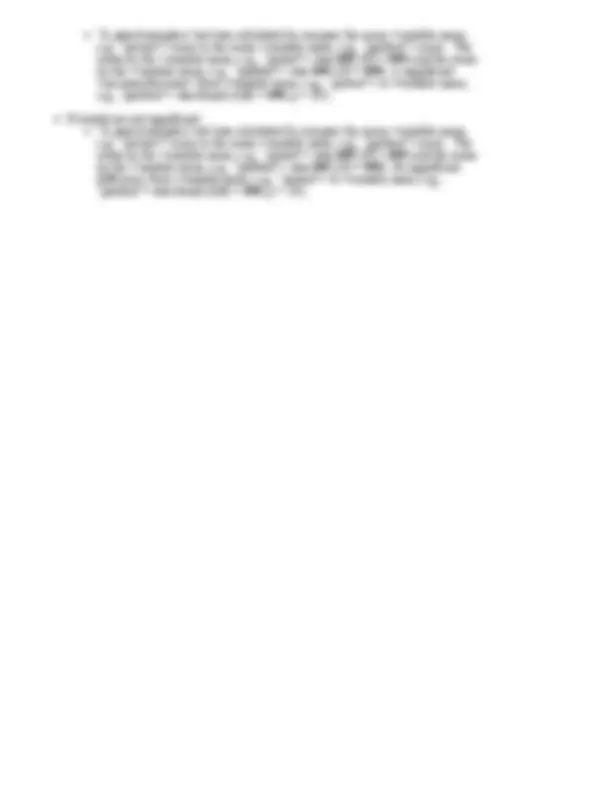



Study with the several resources on Docsity

Earn points by helping other students or get them with a premium plan


Prepare for your exams
Study with the several resources on Docsity

Earn points to download
Earn points by helping other students or get them with a premium plan
Community
Ask the community for help and clear up your study doubts
Discover the best universities in your country according to Docsity users
Free resources
Download our free guides on studying techniques, anxiety management strategies, and thesis advice from Docsity tutors
An overview of reporting results from quantitative research studies, focusing on correlation analysis and means comparison testing. It covers apa style guidelines, correlation statistics and interpretation, pearson and spearman correlation coefficients, and means comparison tests such as t test and anova. It also includes examples of phrasing results for correlation and means comparison.
What you will learn
Typology: Study Guides, Projects, Research
1 / 3

This page cannot be seen from the preview
Don't miss anything!


When reporting the results from a quantitative research study there are some general
guidelines to follow. This overview will address a few of types of analyses and describe appropriate ways to describe the results.
APA Style: Basics
APA style dictates reporting the exact p value within the text of a manuscript (unless the p value is less than .001). Generally, most statistics should be rounded to two decimal places. Generally, percentages are displayed in parentheses with no decimal places, for example (38%). Mean and Standard Deviation presented within parentheses, with M = mean and SD = standard deviation, for example ( M = 22.43, SD = 2.77). Statistical symbols should be italicized.
Correlation: Foundations
Correlation analysis allows the determination of the strength of the linear relationship between two variables. A correlation statistic may range from -1 to 1, with "0" indicating no
relationship, and -1 or 1 indicating a perfect relationship (this means you could perfectly predict one variable if you knew the value of the other). The sign of the statistic indicates
direction, that is a negative sign indicates that as one variable increases in value the other decreases. A positive sign indicates that as one variable increases so does the other.
Although some researchers debate the meaning of specific correlation values, Cronk (2008), indicates that a correlation value >.7 be considered strong, .7-.4 to be moderate, and .3 or
less to be weak.
Correlations can be measured with either the Pearson product-moment correlation
coefficient (r) or the Spearman rho correlation coefficient (r sub s (rs)). The Pearson
procedure is a parametric procedure and thus is stronger than Spearman rho , however, r
relies on a more stringent set of assumptions then rho and thus may not always fit the particular situation.
Pearson product-moment correlation calculation is based on the assumptions that both variables are measured on interval or ratio scales (or dichotomous nominal data), that the
data is normally distributed, and that the relationship between the variables linear. It is a parametric procedure.
Spearman rho correlation coefficient calculation is based on the assumption that both variables are measured on at least an ordinal scale (interval and ratio work as well), but the
data does not need to be normally distributed. It is a nonparametric procedure.
When conducting correlation analysis both a correlation statistic is generated as well as the
level of statistical significance. The level of statistical significance provides an indication of the likelihood that the statistic we calculated is due to chance.
Correlation: Phrasing Results Given: r = .815, df = 16, significance level ( p value) =.
"A Pearson correlation coefficient was calculated examining the relationship between "x" and "y". A strong positive correlation was found ( r (16) = .814, p = .02) indicating a
significant linear relationship between the two variables. <then describe the relationship, i.e., "Older students tend to score higher.">
Given: r = .15, df = 22, significance level ( p value) =.
"A Pearson correlation coefficient was calculated examining the relationship between "x" and "y". A weak correlation that was not significant was found ( r (22) = .15, p > .05). <then
describe the relationship, i.e., "Age is not significantly associated with scores.">
Means Comparison Testing
It is common in quantitative research studies to conduct a "means comparison" analysis. This indicates that a variable has been measured for two or more groups (or a single group
being compared to the known value of a population), and the average (that's the "mean") has been calculated for each. Then, the means of the groups are compared to see if they are
different enough to warrant making a claim of a statistical significant difference. Two common statistical procedures used for conducting this analysis are the " t test" and the
ANOVA (Analysis of Variance) procedure. The t test is appropriate when working with two groups, and the ANOVA procedure is used when working with three or more groups.
The assumptions of both a t test and an ANOVA require data to be measured on an interval or ratio scale and that the population data from which the samples were taken to be normally
distributed. Take note however that the t test is robust and can handle violations of the assumption of a normal distribution. The described assumptions are not necessarily
exhaustive and others may exist based on the makeup of the data, refer to a statistical textbook for additional details regarding assumptions of specific statistical procedures.
Types of t Tests Single sample t test Compares the mean of a single sample to a known population parameter. Independent samples t test Compares the means of two samples. Each sample should be normally distributed and independent of each other. Paired samples t test Compares the means of two scores from related samples. For example, comparing a pretest and a posttest score for a group of subjects would require a paired samples t-test.
t Tests: Phrasing Results
Given: Comparing the means of two independent samples.
Note - ### indicates a placeholder which would be replaced with actual calculated values.
"df" = degrees of freedom and the letters "df" should also be replaced with the actual value of the degrees of freedom. M is used to represent the mean; SD is used to represent the
standard deviation. Chevrons "< >" should be replaced with actual content.
If results are significant: "An independent t test comparing the mean scores of <group 1> and <group 2> found a significant statistical difference between the means of the two groups ( t (df) = ###, p < .05). The mean of the group 1 was significantly higher ( M = ###, SD = ###) than the mean of group 2 ( M = ###, SD = ###).
If results are not significant: An independent t test was calculated comparing the mean score of <group 1> to the mean score of <group 2>. No significant difference was found ( t (df) = ###, p > .05). The mean of <group 1> ( M = ###, SD = ###) was not significantly different from the mean of <group 2> ( M = ###, SD = ###).
Given: Comparing the means of two paired samples.
If results are significant: